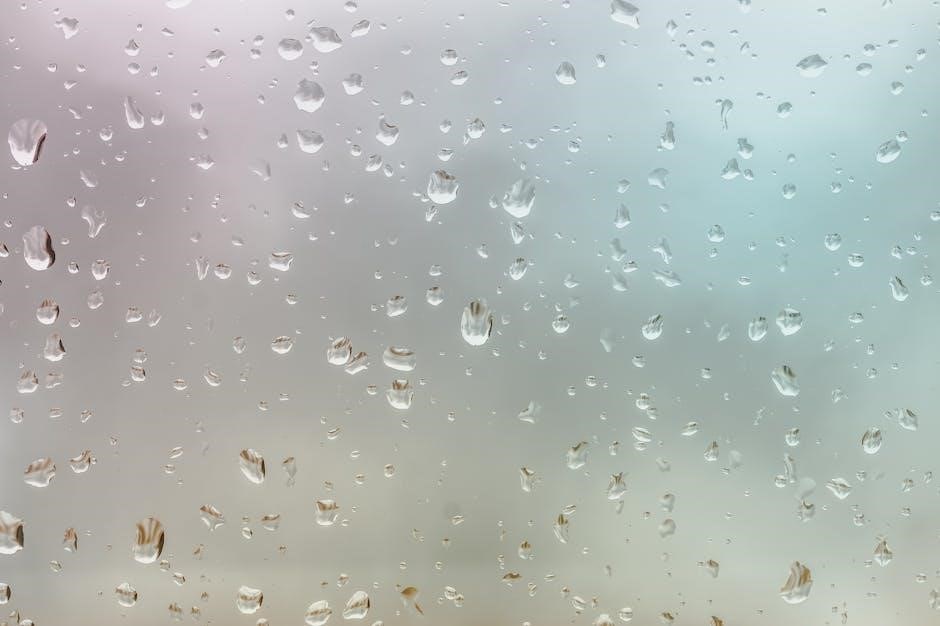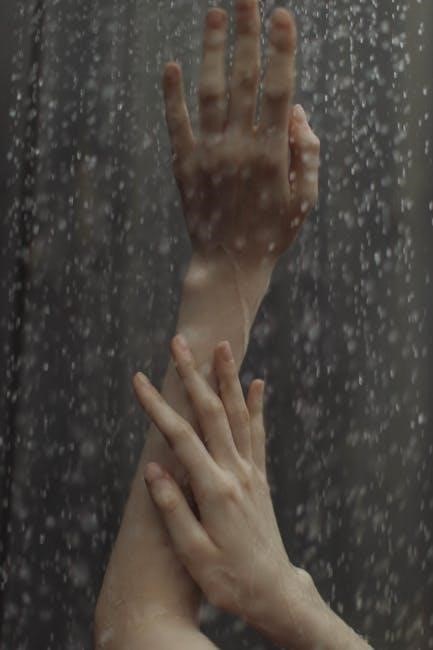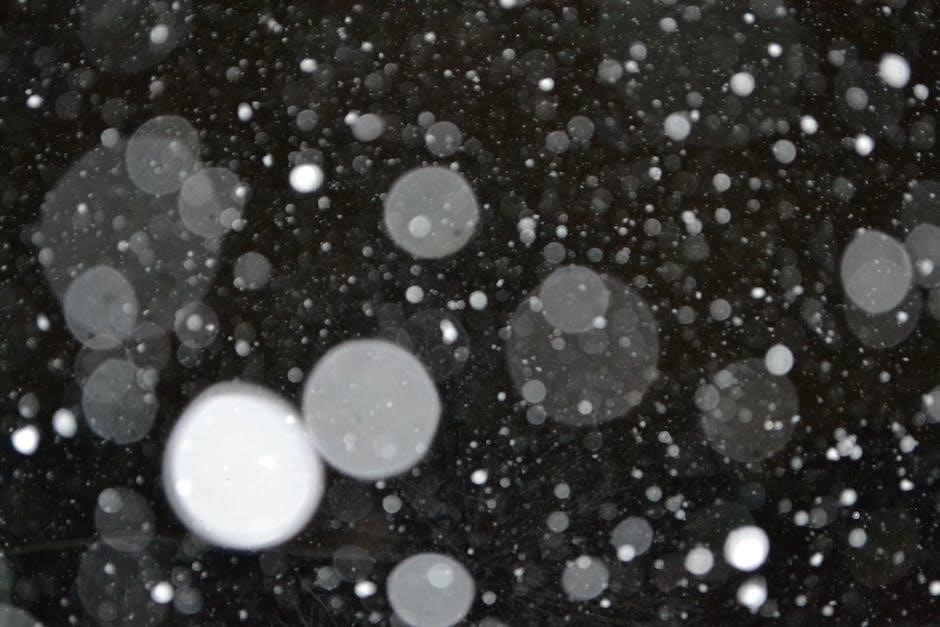Title
There Will Come Soft Rains is a haunting short story by Ray Bradbury, first published in 1950. The title, inspired by a poem by Sara Teasdale, reflects the story’s themes of inevitability and the clash between nature and technology. The narrative is set in a futuristic, post-apocalyptic world, where an automated house continues its routine long after its inhabitants have vanished. This eerie tale is part of Bradbury’s iconic collection The Martian Chronicles, exploring humanity’s fragile existence and the consequences of technological overreach.
Ray Bradbury, a celebrated American author, is best known for his contributions to science fiction, fantasy, and horror. Born in 1920, Bradbury gained prominence for his poetic prose and exploration of futuristic themes. His works often blend nostalgia with cautionary tales about technology and humanity. Among his notable writings is the short story “There Will Come Soft Rains,” which first appeared in 1950. This story is part of Bradbury’s anthology The Martian Chronicles, a collection of interconnected tales that explore humanity’s colonization of Mars and its consequences.
The story is set in a post-apocalyptic world where a technologically advanced house continues to function despite the absence of its human inhabitants. Bradbury uses this setting to reflect on themes such as the futility of human achievement and the inevitable clash between nature and technology. The narrative is both haunting and poetic, with a focus on the house’s automated routines and its eventual confrontation with a resilient tree. Bradbury’s unique style and imaginative vision make “There Will Come Soft Rains” a timeless commentary on the transience of human endeavors and the enduring power of nature.

Plot Summary
The story unfolds in a post-apocalyptic world where a fully automated house continues its daily routines. A migrating tree crashes into the house, disrupting its functions. A fire breaks out, destroying the house, symbolizing humanity’s fragile legacy.
Setting
The story is set in a post-apocalyptic future, specifically in the year 2026, in a small town called Allendale, California. The world has been devastated by a nuclear war, leaving no trace of human life. The setting is a stark contrast between the advanced technology of an automated house and the desolate, barren landscape outside. The house, equipped with modern gadgets and a rigid routine, stands as a symbol of human innovation, while the surrounding environment reflects the destruction and emptiness caused by human actions. The time of day is meticulously tracked by the house, emphasizing the structure and order that technology imposes, even in the absence of humanity. The setting creates a haunting atmosphere, blending the eerie silence of a dead world with the mechanical precision of a house that continues to function long after its inhabitants have vanished. This juxtaposition highlights Bradbury’s exploration of technology’s role in a world without humans.

The Automated House
The automated house in “There Will Come Soft Rains” is a central element of the story, representing the pinnacle of human technological achievement. Located in Allendale, California, the house is a fully self-sustaining, futuristic dwelling designed to cater to every need of its inhabitants. It is equipped with advanced machinery, including a mechanical maid, automatic cooking systems, and voice-activated controls. The house operates on a strict schedule, performing tasks such as cooking, cleaning, and even reading poetry at precisely set times. Despite the absence of its human family, the house continues to function flawlessly, oblivious to the catastrophic events that have occurred outside its walls. Its advanced features highlight humanity’s ingenuity and reliance on technology, while its isolation and persistence underscore the indifference of machines to human fate. The house serves as both a marvel of innovation and a haunting reminder of the transience of human existence.
Daily Routine
The automated house in “There Will Come Soft Rains” adheres to a meticulous daily routine, unaffected by the absence of its human inhabitants. Every morning, the house awakens at precisely 7:00 AM, beginning its schedule with the preparation of breakfast. The kitchen whirs to life, cooking eggs and bacon, while the mechanical maid meticulously cleans the floors. The house operates with eerie normality, following a strict timetable that includes chores, meal preparations, and even leisure activities. At 8:00 AM, the house reads a poem by Sara Teasdale, symbolizing the blending of art and technology in its programming. Despite the desolation outside, the house maintains its routine, oblivious to the catastrophic events that have occurred. Its daily operations highlight the contrast between the order of technology and the chaos of nature. The routine serves as a reminder of humanity’s attempt to impose control over the unpredictable world, even in their absence. The house’s unwavering adherence to its schedule underscores the themes of automation and the futility of human endeavors in the face of inevitable destruction.

Conflict with the Tree
In “There Will Come Soft Rains,” the conflict with the tree serves as a pivotal moment in the story, disrupting the otherwise seamless operation of the automated house. A branch from a nearby tree breaks through a window, shattering the glass and triggering a chain of events. The house, programmed to maintain order, attempts to address the intrusion by dispatching its mechanical maid to clean the mess. However, the sticky sap from the tree interferes with the maid’s functions, causing it to malfunction. This unexpected disruption highlights the house’s vulnerability to natural forces it cannot control. The tree’s intrusion symbolizes the uncontrollable power of nature, which ultimately leads to the house’s demise. The conflict escalates when the sap causes a fire, spreading rapidly through the house. Despite its advanced technology, the house cannot withstand the simple yet destructive force of the tree. This clash between nature and technology underscores Bradbury’s exploration of the fragility of human creations in the face of natural forces.

Themes
Bradbury explores themes of technological overreach, humanity’s absence, and nature’s resilience. The story critiques reliance on automation and highlights the inevitability of destruction, contrasting human achievements with nature’s enduring presence and power.
Technology vs. Nature
Ray Bradbury’s “There Will Come Soft Rains” starkly juxtaposes advanced technology with the enduring power of nature. The story revolves around a fully automated house, symbolizing humanity’s overreliance on technology, which continues to function long after its inhabitants have perished. The house, with its robotic servants and programmed routines, embodies human ingenuity and the pursuit of progress. Yet, this technological marvel is powerless against the natural world it seeks to control. A simple tree branch, carried by the wind, proves to be the house’s undoing, highlighting nature’s indifference to human creations. The contrast between the house’s mechanical precision and the organic, unpredictable forces of nature underscores Bradbury’s warning about the limits of technology. While the house represents human achievement, its eventual destruction by nature suggests that technology, no matter how advanced, cannot surpass or replace the natural world. This theme serves as a cautionary tale, urging humanity to respect and coexist with nature rather than attempting to dominate it.
Futility of Human Achievement
Ray Bradbury’s “There Will Come Soft Rains” explores the futility of human achievement through the image of an automated house that persists even after its inhabitants are gone. This technological wonder, designed to manage life’s every detail, reflects humanity’s relentless pursuit of progress. Yet, the story reveals the ultimate futility of such endeavors as the house, with all its advanced systems, cannot escape its own destruction. The house’s continued routine—preparing meals and maintaining order—becomes a meaningless cycle, highlighting the lack of purpose without human presence. The irony is clear: sophisticated technology cannot prevent the house’s downfall, which is triggered by a simple natural event. This underscores the impermanence of human achievements and the limitations of technology against natural forces. Bradbury critiques the belief that human accomplishments ensure survival or permanence, instead emphasizing their vulnerability and inevitable decline.
Inevitability of Destruction

Ray Bradbury’s “There Will Come Soft Rains” underscores the inevitability of destruction through its haunting portrayal of a post-apocalyptic world. The story suggests that destruction is an unavoidable force, regardless of human efforts to prevent it; The automated house, with its advanced technology, symbolizes humanity’s attempt to defy mortality and chaos. However, the house’s meticulous routines and systems are powerless against the natural forces of decay and disaster. The falling tree, which pierces the roof, serves as a catalyst for the house’s destruction, illustrating how even the most seemingly indestructible structures are vulnerable to unpredictable events.
The story also implies that humanity’s own actions contribute to its downfall. The absence of humans and the eerie silence hint at a catastrophic event, likely a nuclear war, which has wiped out life. Bradbury uses this narrative to critique the notion that progress and technology can save humanity from its self-destructive tendencies. The inevitable destruction of the house mirrors the potential fate of human civilization, emphasizing the futility of trying to escape the consequences of its actions.
Ultimately, the story leaves a profound sense of inevitability, as the house’s destruction aligns with the cyclical nature of life and death. Bradbury’s vision serves as a warning about the fragility of human achievements in the face of nature’s indifference and humanity’s own flaws.
Symbolism
Bradbury employs vivid symbolism throughout the story to explore themes of technology, nature, and human legacy, using elements such as the automated house and the recurring tree to reflect broader existential concerns about destruction, futility, and the clash between progress and natural order.
The House
The house in “There Will Come Soft Rains” is a central symbol of humanity’s technological advancement and its ultimate futility. Bradbury portrays it as a fully automated, self-sustaining structure, capable of performing tasks independently, from cooking to cleaning. This represents the pinnacle of human innovation, where technology has surpassed human need, creating a seemingly immortal entity. However, the house’s inability to comprehend the absence of its human inhabitants underscores the hollow triumph of such achievements. Its relentless operation, even after the apocalypse, highlights the disconnection between human creation and the natural world. The house also symbolizes the enduring yet empty legacy of human civilization, continuing its routines without purpose or life to sustain. Its destruction, juxtaposed with the resilience of nature, serves as a poignant reminder of the transience of human endeavors. Through the house, Bradbury critiques the over-reliance on technology and the illusion of permanence it creates, ultimately revealing the fragility of human achievements in the face of uncontrollable forces;

The Clock
The clock in “There Will Come Soft Rains” serves as a symbol of humanity’s pursuit of order, precision, and control over time. It is depicted as a relentless, mechanical heartbeat of the automated house, marking the passage of hours with eerie regularity. Bradbury uses the clock to emphasize the futility of human attempts to impose structure on an inherently chaotic world. Even after the apocalypse, the clock continues to tick, oblivious to the absence of human life. This underscores the irony of human ingenuity: while the clock represents the pinnacle of technological achievement, it becomes meaningless in a world devoid of purpose or life. The clock’s steady rhythm also contrasts with the organic, unpredictable forces of nature, such as the tree that ultimately destroys the house. By focusing on the clock, Bradbury highlights the tension between human-made systems and the natural world, suggesting that no matter how advanced humanity becomes, it cannot escape the inevitability of destruction. The clock’s persistence serves as a haunting reminder of the transience of human accomplishment.
The Tree
In Ray Bradbury’s “There Will Come Soft Rains,” the tree is a symbol of nature’s persistence and inevitability in the face of human-made technology. The tree’s branches are described as perpetually scraping against the house, creating a rhythmic yet ominous sound that underscores the tension between nature and the automated world. The tree’s role in the story is pivotal, as it is the catalyst for the house’s destruction. Its limbs, described as “whisking and brushing” against the windows, suggest a relentless, almost deliberate effort to disrupt the artificial order of the house. Bradbury uses the tree to illustrate the futility of human attempts to control or dominate nature. Even in a post-apocalyptic world, the tree remains, continuing its natural cycle of growth and decay. Its presence serves as a reminder of the enduring power of nature, which ultimately prevails over the technological marvels of humanity. The tree’s destruction of the house symbolizes the inevitable triumph of natural forces over human creations, reinforcing Bradbury’s cautionary message about the limits of technological progress.
The Poem
In Ray Bradbury’s “There Will Come Soft Rains,” the poem of the same name, written by Sara Teasdale, plays a significant role in the story’s narrative and thematic structure. The poem is recited by the automated house as part of its daily routine, creating a stark contrast between its serene and hopeful imagery and the desolate, post-apocalyptic world outside. The poem’s lines, such as “There will come soft rains and the smell of the ground, / And swallows circling with their shimmering sound,” evoke a sense of natural beauty and renewal. However, in the context of the story, these words underscore the irony of a world where such beauty no longer exists. The poem serves as a haunting reminder of what humanity has lost, emphasizing the themes of destruction and the futility of human achievement. Its presence in the story highlights the contrast between nature’s enduring cycle and the irreversible consequences of human actions. The poem’s recitation by the house becomes a poignant symbol of the disconnect between technology and the natural world, reinforcing Bradbury’s warning about the consequences of unchecked technological advancement.
Cultural and Historical Context
Ray Bradbury wrote “There Will Come Soft Rains” during the Cold War era, reflecting fears of nuclear annihilation and technological overreach. The story captures the paranoia and existential dread prevalent in 1950s America, where the threat of global destruction loomed large.
Bradbury’s narrative also critiques post-war optimism, questioning the belief in unending progress. The tale’s desolate future serves as a warning, echoing societal anxieties about the consequences of unchecked technological advancement and humanity’s disconnection from nature.

Cold War Background
Ray Bradbury’s “There Will Come Soft Rains” is deeply rooted in the anxieties of the Cold War era. Written in 1950, the story reflects the widespread fear of nuclear annihilation and the devastating consequences of technological advancement. The automated house, with its intricate mechanisms and isolation from humanity, symbolizes the dual-edged nature of progress.
The story’s apocalyptic setting, where all life has been wiped out except for the house, mirrors the existential dread of the time. The Cold War’s arms race and the threat of mutual assured destruction loomed large over society, and Bradbury’s narrative serves as a cautionary tale about the futility of human achievement in the face of such cataclysmic forces;
Bradbury also critiques the notion of unchecked technological advancement, a theme that resonated strongly during the 1950s. The house’s survival, despite the absence of its human inhabitants, underscores the irony of creating systems that outlast their creators. This tension between innovation and annihilation captures the paranoia and unease of the era.
The poem by Sara Teasdale, which gives the story its title, adds a haunting contrast between nature’s enduring beauty and humanity’s self-destructive tendencies. This duality reflects the broader cultural anxiety of the Cold War period, where the pursuit of progress seemed to jeopardize the very survival of humanity.
Place in The Martian Chronicles
“There Will Come Soft Rains” is a pivotal story within Ray Bradbury’s seminal work, The Martian Chronicles, a collection that explores humanity’s colonization of Mars and the complexities of technological and societal progress. While the story itself is set on Earth, it serves as a bridge between the book’s Earth-based narratives and its Martian-focused tales, emphasizing the interconnectedness of human folly and the universe.
Chronologically, the story occurs near the end of the collection, reflecting on the aftermath of a global catastrophe. It complements the broader themes of The Martian Chronicles, such as the consequences of unchecked technological advancement and humanity’s disconnection from nature. The automated house, in particular, symbolizes the hubris of human innovation, a recurring motif in the book.
The story’s inclusion in The Martian Chronicles underscores Bradbury’s warning about the dangers of neglecting the natural world. While much of the collection focuses on Mars as a frontier of hope and despair, “There Will Come Soft Rains” grounds these themes in a haunting vision of Earth’s potential demise, serving as a cautionary tale about the consequences of human ambition.
Adaptations and References

Ray Bradbury’s “There Will Come Soft Rains” has been widely adapted and referenced in various forms of media, showcasing its enduring impact. One notable adaptation is the 1950 radio dramatization by X Minus One, which brought the story to life through audio narration and sound effects. Additionally, the tale has been adapted into animated short films, including a 1984 Soviet production titled There Will Come Soft Rains, which visually interpreted the story’s haunting atmosphere and themes.
The story has also inspired references in popular culture. For instance, the heavy metal band The Misfits wrote a song titled “There Will Come Soft Rains” as a tribute to Bradbury’s work. Furthermore, the story’s imagery and themes have influenced numerous works of art, literature, and music, cementing its place in the cultural zeitgeist.
These adaptations and references highlight the story’s universal appeal and its ability to transcend the written word. Bradbury’s vivid imagery and poignant themes continue to resonate with audiences, making “There Will Come Soft Rains” a timeless classic in both literature and multimedia formats.

Analysis
Bradbury’s “There Will Come Soft Rains” masterfully explores themes of technology, nature, and humanity’s fleeting existence through vivid imagery and haunting irony. The story’s tone shifts from eerie silence to tragic inevitability, underscoring the futility of human achievement. By juxtaposing an automated house with a resilient tree, Bradbury highlights nature’s indomitable will. The poem’s recitation serves as a poignant reminder of art’s enduring legacy, contrasting with the transience of human creation. This dichotomy leaves readers contemplating the consequences of unchecked technological advancement and humanity’s place in the natural world.
Literary Devices and Style
Ray Bradbury’s “There Will Come Soft Rains” is a masterclass in literary craftsmanship, employing a range of devices to create a haunting and thought-provoking narrative. Bradbury’s prose is poetic and evocative, with vivid imagery that immerses readers in the post-apocalyptic world. His use of personification is particularly striking, as the empty, automated house is imbued with a sense of mournful consciousness, emphasizing its isolation and futility. The story’s structure, which juxtaposes the mundane routines of the house with the ominous presence of the tree, builds tension through contrast. Bradbury also employs irony, as the house’s meticulous preparation for a family that no longer exists underscores the futility of human achievement. The inclusion of Sara Teasdale’s poem adds a layer of symbolism, its hopeful tone clashing with the bleak reality of the story. Bradbury’s concise, lyrical style amplifies the emotional impact, making the tale both a meditation on technological hubris and a poignant reflection on the transience of life. His writing style, blending the fantastical with the familiar, leaves a lasting impression on readers.
Irony in the Ending
The ending of “There Will Come Soft Rains” is a masterful example of dramatic irony, leaving readers with a haunting sense of inevitability. The automated house, symbolizing human ingenuity and progress, is destroyed not by war or external forces but by a simple tree branch. This twist underscores the futility of human achievement in the face of nature’s indifference. The house, programmed to perpetually serve its absent owners, continues its routine even as destruction looms, highlighting the absurdity of unchecked technological advancement;
The poem recited by the house, “There Will Come Soft Rains,” serves as a stark contrast to the apocalyptic reality. The house’s obliviousness to its impending doom mirrors humanity’s own blindness to the consequences of its actions. Bradbury’s use of irony emphasizes the idea that even the most advanced creations cannot escape the forces of nature or the inevitability of destruction. This poignant conclusion leaves readers reflecting on the fragility of human endeavors and the unstoppable power of the natural world.
Message About Technology
In “There Will Come Soft Rains,” Ray Bradbury delivers a profound message about technology through the depiction of an automated house that continues to function long after its human inhabitants have vanished. The story critiques the notion that technological advancement is inherently beneficial, suggesting instead that it can lead to alienation and destruction. The house, with its elaborate systems for cooking, cleaning, and maintaining order, symbolizes humanity’s obsession with creating a perfect, efficient world. However, this perfection is hollow, as the absence of human life renders the technology meaningless.
Bradbury also highlights the futility of relying on technology to control or dominate nature. The conflict between the house and the tree—symbolizing the natural world—demonstrates that technology, no matter how advanced, cannot overcome the forces of nature. The house’s attempts to destroy the tree ultimately lead to its own demise, illustrating the limits of human ingenuity.
The story serves as a cautionary tale about the dangers of unchecked technological progress. Bradbury warns that while technology may promise comfort and security, it can also isolate humanity from the natural world and from each other, leading to a bleak and empty existence.


